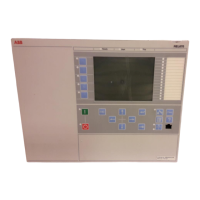When OpMode is set to 2I0 and fi the function will operate if the residual current is
larger than the setting INDir>
and the residual current angle is within the sector
RCADir ± ROADir.
The characteristic for this OpMode when RCADir = 0° and ROADir = 80° is shown
in Figure
61.
-2U
0
Operate area
2I
0
RCADir = 0º
ROADir = 80º
IEC16000129-1-en.vsdx
IEC16000129 V1 EN-US
Figure 61: Characteristic for RCADir = 0° and ROADir = 80°
DirMode is set Forward or Reverse to set the direction of the operation for the
directional function selected by the OpMode.
All the directional protection modes have a residual current release level setting
INRel> which is set in % of IBase. This setting should be chosen smaller than or
equal to the lowest fault current to be detected.
All the directional protection modes have a residual voltage release level setting
UNRel> which is set in % of UBase. This setting should be chosen smaller than or
equal to the lowest fault residual voltage to be detected.
tDef is the definite time delay, given in s, for the directional residual current
protection.
tReset is the time delay before the definite timer gets reset, given in s. With a tReset
time of few cycles, there is an increased possibility to clear intermittent earth faults
correctly. The setting shall be much shorter than the set trip delay. In case of
intermittent earth faults, the fault current is intermittently dropping below the set
value during consecutive cycles. Therefore the definite timer should continue for a
certain time equal to tReset even though the fault current has dropped below the set
value.
1MRK 506 375-UEN A Section 8
Current protection
Railway application RER670 2.2 IEC 181
Application manual

